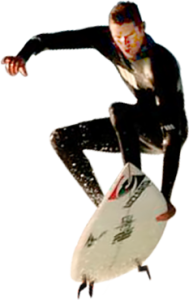
Endless Summer: Surf Injuries by Amy Haverkamp
 In Pacific Beach, we are starting to see more and more surf injuries with the travel and tourism season beginning to take off. Some injuries or conditions are progressive with our experienced locals, while others remain spontaneous with our “groms” (kids) and tourists. Please make yourself aware of some of the more common injuries that we see at our clinic from surfing.
In Pacific Beach, we are starting to see more and more surf injuries with the travel and tourism season beginning to take off. Some injuries or conditions are progressive with our experienced locals, while others remain spontaneous with our “groms” (kids) and tourists. Please make yourself aware of some of the more common injuries that we see at our clinic from surfing.
Lacerations to the Hands and Feet
Many of these lacerations are a result from the coral reef or the surfboard fin. The issues that can be associated with these lacerations include profuse bleeding and infection. Our waters tend to be safe in So Cal, however, it’s important to know that during the wet weather months you should stay out of the water after extended periods of rain. Remember that harbors and spillway mouths are at a higher risk of being contaminated by disease-causing pathogens. Everyone should be aware of the risks of surfing after it rains. Some of these risks include Hepatitis A, respiratory illnesses, ear, nose and throat problems, and GI issues. Another infection to be aware of in breaks with live reef is staph infection. To protect yourself, it’s recommended to invest in booties, a hard shelled helmet for sharp reef breaks, know your breaks prior to paddling in, and if you are traveling, get to know the locals surfing the breaks at your favorite destination.
If you get a laceration:
- Clean the wound and add a sterile compression while trying to keep the affected area above heart level to reduce the bleeding.
- If the bleeding repeatedly makes its way through the bandages, then stitches are likely to be needed.
- If the bleeding is profuse then apply as much pressure as you can and head immediately to a doctor or urgent care.
Head Trauma
Trauma from a collision with the sandbar or a surfboard’s rails, fins, and nose is the most common cause of acute surfing injuries, according to Conservative Management of Sports Injuries. To avoid this, you can ride a soft top surfboard, which can be purchased at your local Costco for a reasonable price. If you experience an injury to the head or neck and note any nausea, ringing of the ears, confusion, blurred vision, or headaches, these symptoms could be signs of a concussion which is a traumatic brain injury (TBI). A concussion may occur after a blow to the head or a period of violent shaking, and is especially common among athletes involved in conta ct sports. If you think that you may have a concussion, it is important to see a physician who knows how to properly diagnose and treat head injuries.
ct sports. If you think that you may have a concussion, it is important to see a physician who knows how to properly diagnose and treat head injuries.
Concussion treatment involves plenty of rest to address symptoms, such as headaches. The doctor should provide concussion patients and their families with ample information regarding the specifics of their condition and establish a pattern of follow-up care to promote healing. Should a patient display long-term concussion side effects, the physician will make a referral to a neurologist to monitor the patient’s progress.
Shoulder Strain
We see all ages of the surf community at our clinic for a common issue which is chronic shoulder impingement from overuse. For those just starting to venture into the water, shoulder strain could simply be a result from using a poor paddling technique. The more seasoned surfer can also experience this from years of paddling and potentially not stretching properly prior to a session. Regardless of age, experience, or gender, stretching plays an important key factor for prevention. For the pre-session stretch try a single leg balance reach, reverse lunge twist, and the side to side lunge. Save the static stretching, where you lengthen and hold, for post surf.
Surfer’s Eye
The symptoms of surfer’s eye include a growth of pink, fleshy tissue on the white of the eye. Often the eye has a gritty feeling, is itchy, and blurry vision. The growth usually forms on the side closest to the nose and grows toward the center of the eye. Although it’s not serious, it can be quite annoying as it creates the sense there is something constantly in the eye. The occurrence is much greater among people who live by the equator, or sunny areas like that of Southern California. It’s most often seen in young adults ages 20 to 40 and it’s more common in men than women. Prevention is key by wearing sunglasses, washing your face with warm water after a surf session, maintaining healthy air indoors, and applying a moisturizing eye mist.
The information provided is for general interest only and should not be misconstrued as a diagnosis, prognosis or treatment recommendation. This information does not in any way constitute the practice of medicine, or any other health care profession. Readers are directed to consult their health care provider regarding their specific health situation. Marque Medical is not liable for any action taken by a reader based upon this information.
